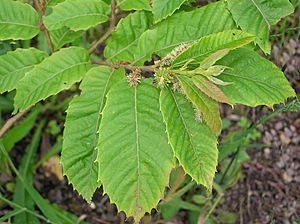Castanea seguinii facts for kids
Quick facts for kids Castanea seguinii |
|
|---|---|
 |
|
| Scientific classification | |
| Genus: |
Castanea
|
| Species: |
seguinii
|
| Synonyms | |
|
Castanea davidii Dode |
|
The Seguin chestnut (scientific name: Castanea seguinii) is a type of chestnut tree. It is also known as Seguin's chestnut or Chinese chinquapin. This tree is originally from the south-central and southeast parts of China. In Chinese, it is called mao li.
Contents
What Does the Seguin Chestnut Look Like?
The Seguin chestnut is usually a small tree or a shrub. It rarely grows taller than 12 meters (about 39 feet).
Leaves and Stems
The leaves of the Seguin chestnut have small, narrow leaf-like parts called stipules. These are about 0.7 to 1.5 centimeters long and fall off when the tree produces fruit. The leaf stems (petioles) are short, about 0.5 to 1.5 centimeters long.
The leaves themselves are 6 to 14 centimeters long. Their undersides have yellowish-brown or gray dots that look like scales. When the leaves are young, they might have a few hairs along their veins. The shape of the leaves can be oblong (longer than wide) or oval. Their base is usually rounded, and the tip is pointed. The edges of the leaves have rough, saw-like teeth.
Flowers and Nuts
The male flowers of the Seguin chestnut grow in long, hanging clusters called catkins, which are 5 to 12 centimeters long. The female flowers are found in a special cup-like structure called a cupule. Each cupule usually holds one or two female flowers.
The cupules grow to be 3 to 5 centimeters wide. They are covered with spiky, hairy parts that are 6 to 10 millimeters long. Inside each cupule, you will find two or three nuts. Each nut is about 1.5 to 2.0 centimeters across.
Where Does the Seguin Chestnut Live?
Seguin chestnut trees grow in mixed forests and thick bushes. They are found in areas that are 400 to 2000 meters (about 1,300 to 6,500 feet) above sea level.
Animals and the Chestnut
In its natural home, the bark of the Seguin chestnut is a food source for golden snub-nosed monkeys during winter. These monkeys are a type of monkey found in China.
Life Cycle of the Tree
The Seguin chestnut flowers from May to July. Its nuts ripen and are ready to be picked from September to November.
How Do People Use Seguin Chestnuts?
The nuts of the Seguin chestnut are small, but they are safe to eat. Local people sometimes gather them from the wild or grow them to eat.
Firewood and Farming
People also use the Seguin chestnut for firewood. They use a method called coppicing. This means they cut the tree down to the base, and new shoots grow from the stump. This way, they can harvest wood again and again.
Protecting Other Trees
In China, the Seguin chestnut is used to protect other valuable chestnut trees. Farmers plant a hedge of Seguin chestnuts around their Chinese chestnut orchards. A tiny wasp, called the gall wasp, likes to attack chestnut trees. When these wasps arrive, they attack the Seguin chestnut trees first. Since the Seguin chestnuts are less valuable, farmers can cut off the infected branches and destroy them. This helps protect the more important Chinese chestnut trees.
See also
 In Spanish: Castaño Seguin para niños
In Spanish: Castaño Seguin para niños

